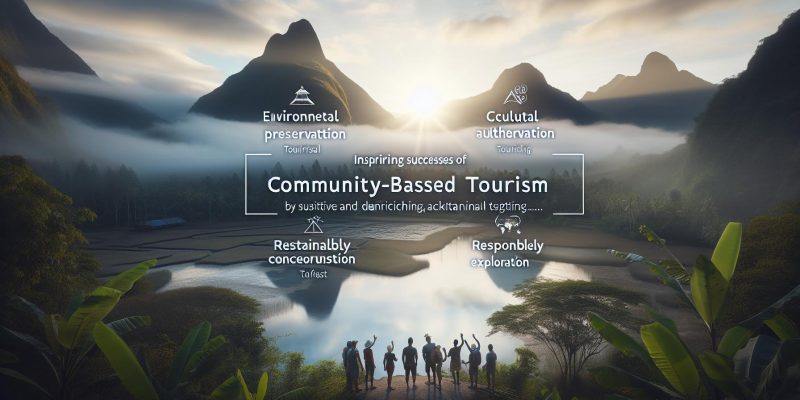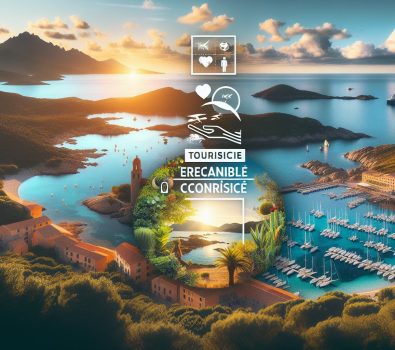As teh impacts of mass tourism become increasingly evident, communities around the globe are turning to sustainable alternatives that provide authentic experiences while preserving local culture. Discover how community-based tourism not only empowers residents but also enriches traveler experiences, showcasing inspiring success stories that highlight this transformative approach to tourism.
Understanding Community based Tourism: A Holistic Approach
Embracing the Essence of Community-based Tourism
At its core, community-based tourism (CBT) offers travelers an unparalleled opportunity to reconnect with nature and culture, providing experiences that are often lost in conventional tourist traps. By engaging directly with local communities, tourists not only witness the rich tapestry of traditions and lifestyles but also contribute to the sustainability of these environments. This holistic approach prioritizes community involvement, ensuring that the very essence of the destination is preserved and celebrated.
Key Elements of Community-Based Tourism:
- Local Engagement: Tourists stay with families, participate in daily activities, and learn about cultural practices firsthand.
- Sustainable Growth: CBT initiatives aim to uplift local economies by providing income opportunities through homestays,tours,and unique artisan crafts.
- Environmental Stewardship: Many CBT projects emphasize conservation efforts, helping to protect local ecosystems while educating visitors on sustainable practices.
Inspiring Examples of Community-Based Tourism
Around the globe, communities are harnessing the power of CBT to carve out prosperous tourism models that benefit both guests and locals. For example, in regions like Southeast Asia, homestays have emerged as a pivotal feature of CBT. Here,tourists can stay in local homes,experiencing authentic cuisine and cultural traditions while supporting family incomes. Such initiatives not only create memorable experiences but also foster cultural exchange and understanding.
| Destination | Key Features | Impact on Community |
|---|---|---|
| Southeast Asia | Homestays, local cuisine, cultural workshops | Increased income for families, preservation of traditions |
| South America | ecotours, artisan markets | Employment opportunities, promotion of local craftsmanship |
| Africa | Wildlife conservation, community engagement | Sustainable practices, funding for local initiatives |
By embracing these community-driven initiatives, travelers can leave a positive imprint on local environments and economies. Understanding community-based tourism through these inspiring success stories not only enriches one’s travel experience but also contributes to a greater purpose, creating a sustainable network of cultural recognition and environmental conservation.
The Benefits of Community Involvement in tourism Development
The Value of Engaging Communities in Tourism Development
When local communities take an active role in tourism development, the results can be both transformative and inspiring. Community involvement not only invites a wealth of traditional knowledge and cultural richness into the tourism experience but also fosters a sense of ownership among residents. This, in turn, encourages sustainable practices and enhances the overall visitor experience. A poignant example can be found in various Community Based Tourism (CBT) projects worldwide, where local input has substantially shaped successful initiatives, ensuring that tourism aligns with community values and environmental standards.
- Economic Empowerment: local communities benefit directly from tourism revenue through job creation, craft markets, and service offerings. Empowering residents to partake in tourism initiatives leads to economic growth that is reinvested into the community.
- Cultural Preservation: Engaging the community in tourism helps preserve local traditions, languages, and craftsmanship.Visitors gain authentic experiences while communities maintain their heritage.
- Environmental Stewardship: Local involvement frequently enough results in a greater commitment to managing local natural resources responsibly. Communities become stewards of their environment, ensuring sustainable practices that protect ecosystems.
- Social Cohesion: Tourism initiatives can unite communities by creating shared goals and fostering collaboration between residents, enhancing social networks and community spirit.
Real-World Examples of Successful Community Involvement
Across the globe, numerous inspiring stories illustrate the benefits of community involvement in tourism. In Bhutan, as an example, the government’s focus on Gross National Happiness encourages community-led tourism that emphasizes culture and environmental sustainability.Villages collaborate to offer visitors authentic experiences, such as homestays and guided treks, all while ensuring that any profits return directly to the local economy.
Another notable example comes from Mexico, where Indigenous communities have developed cultural tourism programs that highlight traditional practices and lifestyles. This initiative not only generates income but also educates visitors about Indigenous cultures, fostering respect and understanding. Such examples exemplify how community-based tourism models can be adapted to fit local contexts, promoting beneficial outcomes for both residents and tourists alike.By embracing community involvement in tourism development, projects can cultivate a rich tapestry of experiences that are mutually beneficial, ensuring that tourism enhances rather than detracts from the cultural and natural heritage of the area. The resonance of community-based tourism serves as a powerful reminder of the profound connection between place, people, and preservation, crafting stories and experiences that inspire travelers globally.
Spotlight on Successful Community Tourism Models worldwide
Transformative Impacts of Community-Based Tourism
Community-based tourism stands out as a powerful tool for social and economic transformation. By focusing on collaborations between travelers and local communities, these models cultivate a mutually beneficial relationship that enhances cultural exchange while empowering local economies. One prominent example is the Finca Luna Nueva Lodge in Costa rica, where local farmers play a central role in the tourism experience. This lodge not only provides organic meals sourced from nearby farms but also actively engages in conservation efforts, creating a sustainable model that highlights the importance of local biodiversity and environmental preservation [[2]].
Case Studies: Success in Latin America
countries throughout Latin america set a precedent with successful community tourism initiatives, investing a remarkable USD 3.89 billion from 2018 to 2023. This investment has birthed over 80 new community tourism projects, demonstrating a growing commitment to empowering local residents while promoting eco-tourism. These initiatives are designed to enhance visitor experiences while ensuring that community members reap the benefits of tourism. For instance, the impact of social tourism projects can be seen in local arts and crafts, which not only provide additional income for artisans but also help keep cultural heritage alive.[[3]]
A Sustainable Path Forward
As the global market for community-based tourism reached an estimated USD 575.9 million in 2022, it illustrates a shift toward sustainable travel practices that prioritize earnest connections with local communities. Tourists today are increasingly seeking authentic experiences, prompting a paradigm shift in how destinations approach tourism. Communities are encouraged to develop their tourism offerings by engaging in community-led planning, ensuring that strategies align with local values and environmental goals.
To achieve success in community tourism, stakeholders can consider the following actionable steps:
- Engage Local Communities: Involve local members in the planning process to ensure their needs and aspirations are met.
- promote Cultural Heritage: Highlight local traditions, cuisine, and crafts to create a richer experience for visitors.
- Focus on Sustainability: Implement eco-friendly practices to attract conscious travelers who value environmental stewardship.
- Measure Impact: Regularly assess the social, economic, and environmental impacts of tourism to adapt and improve strategies.
By crafting these community-based tourism examples, destinations can not only enhance their economic viability but also foster connections that lead to long-term sustainability and cultural resilience.
Lessons from Local Cultures: what They Teach Us About Sustainable Travel
An increasing number of travelers are seeking experiences that resonate with local authenticity,drawing from the deep wisdom embedded within cultures around the globe. Community-based tourism (CBT) provides a unique lens through which we can understand sustainable travel. In places where communities engage directly with visitors, we witness not just the preservation of cultural practices, but a symbiotic relationship where both locals and travelers benefit.
Empowerment through Engagement
One of the moast profound lessons from CBT is the concept of empowerment through engagement. When local residents actively participate in the tourism process, they maintain control over their cultural narratives and economic advantages. such as, in various regions of Nepal, communities have adopted CBT models that allow them to share their traditions while providing economic opportunities related to homestays and guiding services. This model not only preserves local customs but also fosters a sense of ownership and pride among community members, which in turn enhances the visitor experience by providing an authentic interaction with the culture [[1]].
Minimizing Impact
Another significant takeaway from CBT is the commitment to minimizing the environmental impact of tourism. By encouraging responsible travel practices, local cultures teach us the importance of sustainability. CBT initiatives often focus on eco-friendly accommodations, local sourcing of food, and culturally respectful interactions that reduce carbon footprints. Initiatives, such as those developed by WWF Nepal and Intrepid, illustrate how local tourism development can align with environmental stewardship to create more sustainable travel experiences while supporting the local economy [[2]].
Adapting to Change
Moreover, local cultures exemplify resilience and adaptability in the face of increasing global pressures. As tourism continues to evolve, communities that harness their unique attributes and adapt their offerings based on visitor interests not only thrive but also enrich the travel experience. Community-based tourism encourages flexibility—offering diverse experiences from cultural immersions to adventure tourism—proving that sustainable travel can cater to a variety of preferences while still respecting local traditions [[3]].
| Key Lessons | Application to Travel |
|---|---|
| Empowerment through engagement | enable local communities to share their stories and control their tourism narrative. |
| Minimizing impact | Adopt eco-friendly practices and support local economies. |
| adapting to change | Encourage flexible offerings that respect and preserve local culture. |
Informed by these inspiring community-based tourism examples, travelers are encouraged to engage thoughtfully with local cultures, fostering a deeper connection that benefits all stakeholders involved. Through CBT, we can learn to appreciate not only the beauty of our shared planet but also the rich tapestry of human experience that makes travel worthwhile and sustainable.
Creating Authentic Experiences: Engaging travelers in Local Traditions
Immersing in Local Practices
Travelers seeking genuine cultural experiences often find themselves enthralled by local traditions that tell the stories of a community. Engaging in community-based tourism allows visitors not only to witness these practices but to actively participate in them, creating a memorable connection with the people. Such as, in the Ccaccaccollo community of Peru, travelers can join in traditional weaving workshops led by local artisans. This direct involvement not only enriches the travel experience but also supports the artisans economically, ensuring that these age-old traditions are preserved for future generations.
Building Bridges Through Cultural Exchange
Participating in local customs fosters a deeper understanding between travelers and host communities, transforming a typical vacation into a meaningful dialog. Engaging with local families during a community homestay offers tourists a firsthand experience of everyday life in the region. From sharing meals to attending local festivals, these interactions encourage cultural exchange that is beneficial for both sides. Communities gain a platform to share their heritage, while travelers leave with a unique insight into the lives of those they visit.
Examples of Engaging in Local Traditions
The successes in community-based tourism often hinge on tour operators who prioritize authenticity and cultural preservation. Operations like Lokal Travel emphasize the importance of local engagement, providing opportunities for visitors to learn local crafts or cooking techniques directly from community members. here are some impactful examples of activities travelers can engage in:
- Artisan Workshops: Participate in pottery making, weaving, or painting workshops to appreciate local craftsmanship.
- Culinary experiences: Join cooking classes that feature traditional recipes, often using locally-sourced ingredients.
- Cultural Festivals: Attend local celebrations or rituals, gaining insights into the meaning and history behind them.
By immersing themselves in these experiences, travelers not only enjoy authentic interactions but also contribute to the sustainability of the community, creating a cycle of support that benefits all. This holistic approach highlights the essence of community-based tourism through compelling stories and inspiring success narratives that encourage deeper engagement with local cultures.
Building Economic Resilience through Community-led Initiatives
Empowering Communities through Sustainable Tourism
By harnessing the power of community-led initiatives, local populations can cultivate economic resilience that not only supports their livelihoods but also reinforces cultural heritage and environmental sustainability.Community-based tourism (CBT) has emerged as a transformative model that thrives on local engagement and has been instrumental in various regions worldwide. Through collaborative efforts, communities are developing their unique tourism offerings, showcasing their culture while generating income and employment opportunities for local residents.
Case Studies of Success
The success of community-based tourism can be observed in many inspiring examples. For instance, in tribal regions, local enterprises often incorporate traditional practices and cultural narratives into their tourism services. This approach allows communities to retain control over their resources and share their stories with visitors, enriching the tourist experience while preserving their lineage. These initiatives provide the tools and infrastructure needed for sustainable economic growth, such as:
- Investment in local guides and training programs
- Development of eco-friendly lodges and attractions
- Promotion of local arts and crafts to enhance visitor engagement
Such endeavors ensure that a significant portion of the tourism revenue circulates within the community, fostering a resilient economy less reliant on external influences.
Strategies for Sustaining Economic Growth
To sustain this momentum,community-led initiatives must adopt a holistic approach. Key strategies include:
- Building Networks: Create alliances with other local businesses and NGOs to share resources and expertise.
- Engaging in Training: Offer workshops for residents to gain skills in hospitality, marketing, and conservation.
- Enhancing Online Presence: Leverage digital marketing to reach potential tourists, promote local experiences, and tell compelling stories about the community’s heritage.
By focusing on these strategies, communities can reinforce their economic foundations, ensuring that tourism serves as a vehicle for empowerment and growth rather than exploitation.
Measuring Impact and Success
it’s crucial for communities to monitor the impact of their initiatives. Tracking metrics such as visitor numbers, income generated, and resident satisfaction can provide valuable insights into the effectiveness of community-led tourism efforts. Regular assessments enable communities to adjust their strategies in response to changing circumstances, maximizing benefits for both residents and visitors.
| Metric | Example Target | Current Status |
|---|---|---|
| Visitor Numbers | 10,000 annual visitors | 8,000 |
| Local Employment | 50 new jobs | 30 |
| Community satisfaction | 80% positive feedback | 75% |
by integrating these practices, communities can effectively build economic resilience through well-structured and sustainable community-based tourism initiatives. This not only enhances their economic stability but also celebrates and maintains the cultural richness that defines their identity.
Challenges and Solutions in Implementing Community Based Tourism
Understanding the Barriers to community Based Tourism
Community-Based Tourism (CBT) holds immense potential for fostering sustainable development within local communities, yet its implementation often faces significant hurdles. One of the primary challenges is the lack of community engagement. For CBT initiatives to thrive, active participation from community members is crucial. Without their involvement, projects can become disconnected from local needs and perspectives. Moreover, many communities might not possess sufficient knowledge about tourism management and related skills, leading to inefficient operational practices.
Economic Constraints and Dependency
another pressing obstacle is economic constraints. Many communities engaged in CBT may find themselves heavily reliant on external funding and expertise, which can undermine local capacity building. This dependency can lead to vulnerabilities, especially in times of economic downturn or crises, such as those witnessed during the COVID-19 pandemic. To mitigate this risk, communities need to develop sustainable revenue streams that are less influenced by external market fluctuations. This can include diversifying tourism offerings, such as combining traditional ecological knowledge with unique cultural experiences.
Environmental and Cultural Impact Management
Balancing tourism profitability with environmental stewardship presents a complex challenge. Many CBT projects may inadvertently promote environmental degradation or cultural commodification, leading to the very issues they seek to address. Successful initiatives must prioritize environmental sustainability by incorporating eco-friendly practices and advocating for the conservation of local ecosystems. Additionally, maintaining the authenticity of cultural expressions is vital for fostering genuine visitor experiences. Collaborating with local experts and cultural custodians can definitely help preserve cultural integrity while providing enriching tourism experiences.
Actionable Solutions for Successful Implementation
To address these challenges effectively, it’s essential to implement certain strategic solutions:
- Community Training and Education: Invest in capacity-building programs that educate local populations about tourism management, marketing, and sustainable practices.
- Diverse Revenue Models: Encourage the development of varied tourism activities to reduce dependency on single sources of funding.
- Collaborative Partnerships: Form alliances with non-profits, government organizations, and academic institutions to foster knowledge sharing and resource allocation.
- Regular Monitoring and Evaluation: Establish frameworks for assessing the impacts of tourism initiatives to adapt and improve continually.
By addressing these barriers with innovative solutions, communities can harness the transformative power of CBT, leading to sustainable economic development while nurturing their cultural and environmental heritage. The stories of successful implementations serve as inspiring examples, highlighting the practical steps necessary to overcome obstacles in the pursuit of sustainable community tourism.
Practical Steps for Developing a Community Based Tourism Project
Engaging Local Communities
To successfully develop a community-based tourism project, the foundation lies in engaging local communities. Understanding their needs,aspirations,and cultural nuances is critical. Initiate the process by forming a community group that includes diverse voices from different sectors—youth, elders, women, and local leaders. Hosting workshops or focus groups can facilitate open dialogue, allowing community members to express their ideas and concerns. This collaboration establishes trust and ensures that tourism development reflects local culture and enhances the community’s identity.
Identifying Unique Resources
Every community possesses unique cultural and natural resources that can be leveraged for tourism. Identifying these assets is crucial in crafting a compelling tourism experience. Consider artistic traditions, ancient sites, natural landscapes, and local cuisine as potential attractions. For instance, a small village may have traditional weaving techniques or unique culinary practices that can provide authentic experiences for visitors.Conducting an asset mapping exercise can help visualize these resources, paving the way for effective marketing strategies and tourism offerings.
Developing Sustainable Practices
Sustainability must be at the core of any community-based tourism initiative. This means not only benefiting the local economy but also ensuring environmental and cultural preservation. establish guidelines for tourism activities that promote respectful and environmentally-friendly practices. Such as, implementing a waste management plan or encouraging eco-friendly accommodations can significantly lessen the environmental impact. Additionally, embracing sustainable practices can enhance the destination’s appeal to eco-conscious travelers, creating a competitive advantage in the crowded tourism market.
Marketing and Building Partnerships
Once the project is underway, the next step is effective marketing and building partnerships. Leverage social media, local tourism boards, and travel influencers to promote the destination’s unique stories and experiences.Partnership with other tourism stakeholders, such as local businesses and NGOs, can provide resources and expertise. Collaborating with these entities can enhance the project’s visibility and credibility, leading to increased tourist interest. Encourage visitors to share their experiences online, creating a ripple effect that draws in more travelers seeking authentic community-based tourism experiences.
| Step | Action | Purpose |
|---|---|---|
| Engage Community | Form a local group and conduct workshops | Establish trust and gather insights |
| Identify Resources | Conduct asset mapping | Highlight unique cultural and natural attractions |
| Sustainability Practices | Develop guidelines and eco-friendly options | Preserve culture and environment |
| Marketing | Utilize social media and build partnerships | Enhance visibility and attract visitors |
With these practical steps in mind, communities can begin to craft their own inspiring success stories in community-based tourism, creating both economic opportunities and a deeper appreciation for their cultural heritage.
How Technology is Empowering Community based Tourism Efforts
transformative Power of Technology in Community-Based Tourism
In an era where digital connectivity shapes our experiences, technology has emerged as a pivotal force in amplifying community-based tourism (CBT) initiatives. By seamlessly integrating innovative tools, local communities can share their culture, traditions, and resources with a global audience. The accessibility of online platforms allows tourists to discover unique experiences, fostering a sustainable and mutually beneficial relationship between travelers and local hosts.
Empowering Local Artisans and Services
One striking example of technology’s impact is the rise of online marketplaces. Platforms such as Airbnb and local community websites empower artisans and service providers by connecting them directly to potential guests. These platforms not only enhance visibility but also improve economic outcomes for local communities. By showcasing authentic experiences — from traditional cooking classes to guided nature walks — CBT operators can attract visitors interested in immersive encounters that reflect the local culture.
Leveraging Social Media for Visibility
Social media channels are vital tools for promoting community-based tourism efforts. By sharing captivating stories, photos, and videos, local communities can engage with a broader audience. For instance, initiatives that curate user-generated content encourage tourists to share their experiences, effectively marketing the destination through authentic testimonials. This organic outreach helps build a loyal customer base and drives interest in lesser-known regions, leading to an increase in visitors and local economic growth.
| Type of Technology | benefits | Example of Application |
|---|---|---|
| Online Booking Platforms | Increased visibility and bookings | Airbnb for homestays |
| Social Media | Engagement and community building | Instagram campaigns |
| Digital Payment Systems | Facilitating transactions | Mobile payments for local tours |
| Virtual Reality (VR) | Immersive experiences for potential tourists | virtual tours of local attractions |
Innovative Collaboration and Resilience
Furthermore, community-based tourism leverages collaborative technology tools to enhance strategic planning and resilience. Digital platforms for project management and communication allow community members to work together efficiently, share resources, and coordinate tourism activities. This collaboration not only strengthens local bonds but also empowers communities to respond dynamically to challenges, such as those posed by environmental changes or economic fluctuations.
As evidenced in various success stories from around the globe, the integration of technology in community-based tourism not only enhances visibility and engagement but also establishes a solid foundation for sustainable economic growth. By embracing technological advancements, communities can create unique and compelling narratives that attract visitors seeking meaningful travel experiences.
In Retrospect
As we reflect on the inspiring success stories of community-based tourism, it’s clear that these initiatives not only empower local communities but also enrich the travel experience for visitors.By embracing sustainable practices and fostering cultural immersion,travelers can contribute to the preservation of unique traditions and natural resources. Engaging with local customs and supporting local economies creates meaningful connections that enhance our understanding of diverse cultures.We encourage you to explore these community-driven models further; whether through researching case studies or planning your next eco-friendly adventure, your choices can make a significant impact. Together, let’s celebrate and support the transformative power of community-based tourism in shaping a more sustainable and inclusive future for travel.








